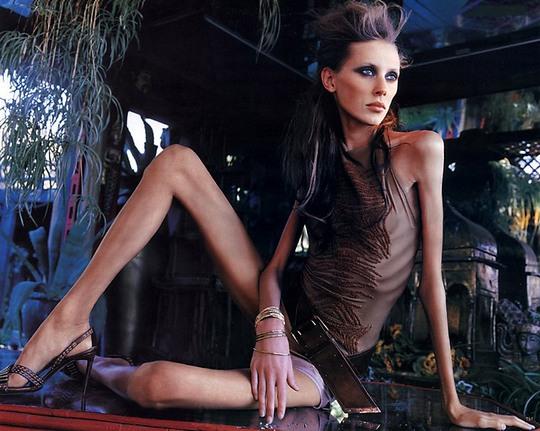
“She could be skinnier.” Since the 1980s, the tone in the feminine media sphere has rapidly transitioned from love for voluptuous figures to obsession over tiny waistlines. This alarming trend, perpetrated by stars like Kate Moss, Nicole Richie, and Mary-Kate Olsen has led to an overwhelming sense of inadequacy in women and girls.
Though some entertainers, like Beyonce and Jennifer Lopez, manage to escape with their curves still intact, the majority of the entertainment industry complies with the craze. Size zero models are strewn across magazines, billboards, and commercials. Twiggy actresses and musicians hold the tops of the charts.
“The media is really aggressive towards powerful women, like their image is more important than their message,” senior Jessica Luhrman said. “It’s really saddening that women have to act, dress, or have a certain body shape to be more accepted.”
Advertising overtly and subliminally promotes the idea that underweight, dolled up women are the most revered and successful, and only by mirroring their example can girls prosper and thrive. This trend has repeatedly shown that women are willing to deprive their bodies and desires in order to achieve the higher purpose of widespread acceptance and being granted titles of grace and beauty.
Society has before imposed on women merciless constraints of handsomeness (i.e. whale-bone corsets, arsenic skin-paler, even high heels), but never have any inflicted such damage on women’s health.

In an effort to adhere to these impossible standards, an estimated 8 million Americans suffer from eating disorders, 95% of which are between the ages of 12 to 25. The disorders, which have the highest mortality rate of any mental illness, manifest in two forms: Anorexia Nervosa, characterized by refusal to maintain healthy food consumption, and Bulimia Nervosa, characterized by binge eating and purging (either by vomiting, laxatives, or excessive exercise).
The illnesses, though different, are born of the same distorted self image and obsessive fear of gaining weight, which most often results in dramatic weight loss and can lead to hypothermia, hair loss, swollen joints and glands, dehydration, infertility, dental erosion, esophagus inflammation, and even cardiac arrest.
There’s nothing wrong with observing proper nutrition and exercising regularly – in fact, doctors encourage it – but the extremes must be looked out for. Nervosa illnesses involve secrecy and withdrawal from friends, family, and social situations, and victims work hard to mask their symptoms – faking normal eating habits, wearing baggy clothes, providing reasonable excuses for skipping meals or heading to the bathroom. Due to this concealment and the illnesses’ difficult detection, only 1 in 10 sufferers receive treatment. Though privacy is a natural right, sensible observation of loved ones is urged, for the illness affects both the minds and bodies of the inflicted, who are often incapable of helping themselves.
With vigilance and care treatment can be accessed. However, a more effective prescription for the underlying problem is fixing society’s mutilated definition of attractiveness. The beauty industry purposefully plays on the unattainable, on weaknesses in confidence, and women and men alike fall prey to these unrealistic representations of perfection. Instead of protruding bones and flat stomachs, health, individuality, and depth of character should be recognized as the true indications of a beautiful person.
After all, as Mark Apopot said, “We cannot limit ourselves to what people say.”
LOOK! —>MissRepresentation: How Media Dictates Gender Expression
























Jesus Zendejo • Dec 6, 2011 at 3:31 pm
I don’t get why people do this. They have to understand that they are perfect just the way they are and that someone will always be thier with them!
Its like that song “Perfect” by Pink